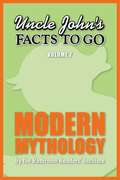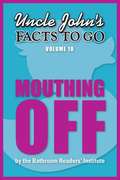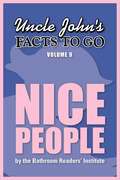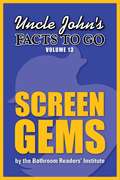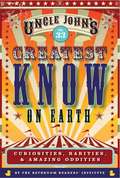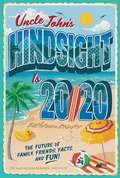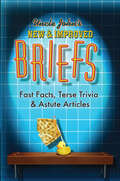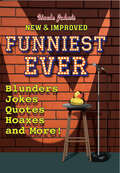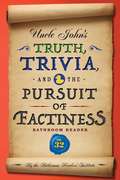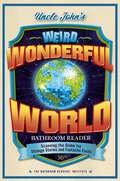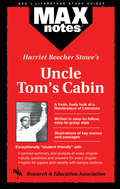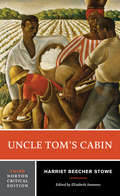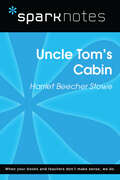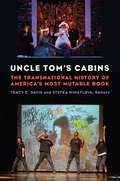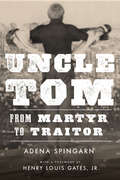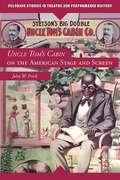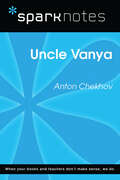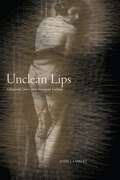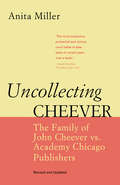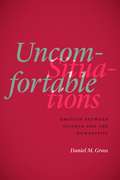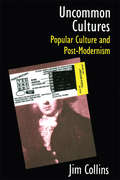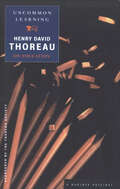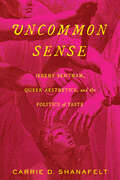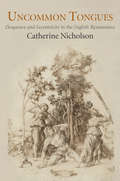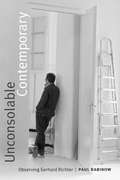- Table View
- List View
Uncle John's Facts to Go Modern Mythology (Facts to Go #7)
by Bathroom Readers' InstituteThe ancient Greeks had Zeus; today we have the Burger King...king. In Modern Mythology, you'll meet the world's most fascinating heroes, villains, and corporate spokesthingies. Featuring Bathroom Reader classics plus a few new treasures, you'll discover truths and untruths, and learn the real stories behind some of today's tallest tales. So sit back and let Uncle John take you on an epic journey of modern make-believe! Immerse yourself in...-Gnomes in the gnews-The Whopperknocker, Whirling Whumpus, and other cousins of Sasquatch-Ronald McDonald's relentless rise to the top-On tour with Paul Bunyan-5 Movies that mythed the point-Who was Kilroy, and why was he here?-Common misconceptions that refuse to go away-Urban Legends that turned out to be true-The secret of the Loch Ness Monster finally explained...and much, much more!
Uncle John's Facts to Go Mouthing Off (Facts to Go #10)
by Bathroom Readers' InstituteIn the 26-year history of the Bathroom Readers' Institute, we have collected tens of thousands of the world's most memorable quotations. In this e-book, you'll find the very best of them (along with some newly-discovered utterances). From the profound to the sublime, from the witty to the stupid, after reading Mouthing Off, you'll never be at a loss for words again! Some highlights:-Surprisingly wise celebrities, cocky rock stars, and dumb jocks-When commentators misspeak, and other foot-in-mouth moments-What Mark Twain didn't say-Hollywood's all-time weirdest acceptance speeches-Talk show guests deemed too mouthy for TV-Wacky 911 calls and court transcripts-Ancient quotes that still resonate today-Modern pearls of wisdom, including actor (and racing enthusiast) Paul Newman's observation: "It is useless to put on your brakes when you're upside down."And much, much more!
Uncle John's Facts to Go Nice People (Facts to Go #9)
by Bathroom Readers' InstituteThis very special e-book will lift your spirits with inspiring stories of heroism, overcoming adversity, random acts of kindness, wise thoughts, and some really weird tales of people who benefitted from amazing luck. So put on your rose-colored glasses and curl up with these Uncle John's gems-both old and new-that prove once and for all, the glass really is half full! Some heartwarming examples:-The origin of Mother's Day-Strangers who saved the lives of strangers-The anonymous good deed that led to the "Pay it Forward" movement-How Rodney Dangerfield finally got some respect-The biologist who wrote a book and gave birth to the modern environmental movement-The bus driver who gave a man his shoes-The heroes of September 11th-Crime-stopping kidsAnd much, much more!
Uncle John's Facts to Go Screen Gems (Facts to Go #13)
by Bathroom Readers' InstituteIf you love movies as much as we do, you won't want to miss this epic e-book! Several classic Bathroom Reader articles, along with a few new ones, will light up your tiny screen with all-things cinema-from the early days of silent movies to the futuristic world of visual effects. You'll laugh at hilarious bloopers and cringe at stunts gone wrong. And you'll never look at movies the same way again. So please turn off your phones and try not talk while you read about...-Awkward movie tie-in products-like Hunger Games silverware-Pulp Fiction, starring Julia Louis-Dreyfus (and other "Almost Cast" actors)-The enormous cajones of Hollywood's stunt drivers-Our bleak future, as predicted by sci-fi movies-What a movie producer actually does all day-Why previews are called "trailers"-The all-time funniest movie lines-Ebert's best barbs-Who was Oscar?...And much, much more!
Uncle John's Greatest Know on Earth Bathroom Reader: Curiosities, Rarities & Amazing Oddities (Uncle John's Bathroom Reader Annual #33)
by Bathroom Readers' InstituteUncle John is back with another spectacular show—and it&’s right here in front of you!Uncle John&’s Greatest Know on Earth Bathroom Reader is bursting with the latest oohs and aahs from the worlds of pop culture, history, sports, and politics. Dazzling facts, jaw-dropping blunders, and astounding lists of trivia will make your visits to the throne room more entertaining than ever. Articles range in length from a single page to extended page-turners, so there&’s always something to suit your needs. With Uncle John as the ringmaster for the 33rd straight edition, this Bathroom Reader is sure to be a crowd-pleaser!
Uncle John's Hindsight Is 20/20 Bathroom Reader: The Future Is Family, Friends, Facts, and Fun (Uncle John's Bathroom Reader Annual #34)
by Bathroom Readers' InstituteThis 34th annual edition of Uncle John&’s Bathroom Reader offers an all-new collection of fascinating trivia, strange-but-true oddities, and the ever-popular stories of dumb crooks!Uncle John&’s Hindsight Is 2020 Bathroom Reader is packed with tons of new articles from the worlds of pop culture, history, and science to help you get everything out of your system the next time you visit the throne room! Articles range in length from a single page to extended page-turners, each as entertaining as the last. From iconic television roles that almost weren&’t to the origins of comic books, this 34th edition of fascinating trivia, hilarious lists, and notable quotes compiled by Uncle John and his team at the Bathroom Readers&’ Institute will set your mind free to roam the world—and you won&’t even need to leave the house!
Uncle John's New & Improved Briefs: Fast Facts, Terse Trivia & Astute Articles
by Bathroom Readers' InstituteNow Uncle John’s fans can get their dose of trivia…on the go!Fresh from the package, Uncle John presents his spanking-clean new and improved Briefs! We’ve refreshed a fan favorite that includes many of the greatest one- and two-page articles we’ve written, with more than twenty-five pages of new content. Uncle John’s New & Improved Briefs is chock-full of thousands of great facts and hundreds of quick hits covering history, origins, blunders, sports, pop science, and entertainment—plus a sprinkling of riddles, puns, anagrams, and other classic wordplay. Just open up to any one of these 288 pages. Who knows what you might find? Read about…The secrets of top-secret spy lingoThe monkey that got a head transplant…and livedBizarre recipes: jellied moose nose, steamed muskrat legs, and haggisThe worst movie bloopers from Best Picture Oscar winnersThe little-known story of the best deal in sports historyThe man behind Death Valley’s “Castle in the Desert”How to decipher the hidden codes on a dollar billSinister left-handed factsEarth’s greatest hitsAnd much, much more!
Uncle John's New & Improved Funniest Ever
by Bathroom Readers' InstituteThe popular bathroom reader series is back with this collection that&’s flush with laughs. It&’s new, it&’s improved, it&’s the funniest ever! Back by popular demand, this newly revised edition includes plenty of all-time favorites, along with more than twenty-five pages of new content. That&’s page after page after page of laugh-out-loud dumb jokes, dumb jocks, toasts, pranks, kings, kittens, caboodles, and, of course, poorly translated kung fu movie subtitles such as &“It took my seven digestive pills to dissolve your hairy crab!&” So, whether you like your humor witty or witless, light or dark, silly or sublime, you&’ll laugh until your head explodes. Chortle at: ·Dumb crooks: The robber who ran face-first into a wall because he forgot to poke eye holes in his pillowcase. ·Witty wordplay: If Snoop Dogg were to marry Winnie-the-Pooh, his name would become Snoop Dogg Pooh. ·Flubbed headlines: &“British Left Waffles On House Floor&” ·Quirky stars: Billy Idol&’s concert rider demands he have one large tub of I Can&’t Believe It&’s Not Butter in his dressing room. ·Job lingo: If you hear an ER doc mention a &“VIP,&” be on the lookout for a &“very intoxicated patient.&” ·Sputtering sportscasters: &“If only faces could talk.&” —Pat Summerall And much, much more
Uncle John's Truth, Trivia, and the Pursuit of Factiness Bathroom Reader (Uncle John's Bathroom Reader Annual)
by Bathroom Readers' InstituteIt’s all about the facts—and Uncle John is back with a ton of them!For the 32nd year, Uncle John and his loyal researchers have teamed up to bring you the latest tidbits from the world of pop culture, history, sports, and strange news stories. If you want to read about celebrity misdeeds, odd coincidences, and disastrous blunders, Uncle John’s Truth, Trivia, and the Pursuit of Factiness has what you need. With short articles for a quick trip to the throne room and longer page-turners for an extended visit, this all-new edition of Uncle John’s Bathroom Reader is a satisfying read.
Uncle John's Weird, Wonderful World Bathroom Reader: Scanning the Globe for Strange Stories and Fantastic Facts (Uncle John's Bathroom Reader Annual #36)
by Bathroom Readers' InstituteUncle John is back with the 36th annual Bathroom Reader, an all-new collection of entertaining articles that explore the weird and wonderful world we live in.In this 36th edition of Uncle John&’s Bathroom Reader, longtime fans and new readers alike will be astounded by a treasure trove of wonderfully weird (and true!) stories that explore the realms of pop culture, history, sports, science, and everyday folks, including the always popular misadventures of dumb crooks. Uncle John and his team at the Bathroom Readers&’ Institute have reached into all corners of the world to bring you this all-new collection of entertaining and informative articles that include short reads for a quick trip to the throne room as well as longer page-turners for when you take an extended visit. You&’ll also find a plethora of amusing lists, odd factoids, quotes, and quizzes that will tickle every trivia enthusiast&’s fancy.
Uncle Tom's Cabin (MAXnotes Literature Guides)
by Edward TangREA's MAXnotes for Harriet Beecher Stowe's Uncle Tom's Cabin MAXnotes offer a fresh look at masterpieces of literature, presented in a lively and interesting fashion. Written by literary experts who currently teach the subject, MAXnotes will enhance your understanding and enjoyment of the work. MAXnotes are designed to stimulate independent thought about the literary work by raising various issues and thought-provoking ideas and questions. MAXnotes cover the essentials of what one should know about each work, including an overall summary, character lists, an explanation and discussion of the plot, the work's historical context, illustrations to convey the mood of the work, and a biography of the author. Each chapter is individually summarized and analyzed, and has study questions and answers.
Uncle Tom's Cabin (Norton Critical Editions #Third Edition)
by Harriet Beecher Stowe Elizabeth Ammons<P>Selling more than 300,000 copies the first year it was published, Stowe's powerful abolitionist novel fueled the fire of the human rights debate in 1852. <P>Denouncing the institution of slavery in dramatic terms, the incendiary novel quickly draws the reader into the world of slaves and their masters. <P>Stowe's characters are powerfully and humanly realized in Uncle Tom, a majestic and heroic slave whose faith and dignity are never corrupted; Eliza and her husband, George, who elude slave catchers and eventually flee a country that condones slavery; Simon Legree, a brutal plantation owner; Little Eva, who suffers emotionally and physically from the suffering of slaves; and fun-loving Topsy, Eva's slave playmate. <P>Critics, scholars, and students are today revisiting this monumental work with a new objectivity, focusing on Stowe's compelling portrayal of women and the novel's theological underpinnings. <P>This Norton Critical Edition includes: <br>The 1852 first book edition, accompanied by Elizabeth Ammons’s preface, note on the text, and explanatory annotations. <br>Twenty-two illustrations. <br>A rich selection of historical documents on slavery and abolitionism. <br>Seventeen critical reviews spanning more than 160 years. <br>A Chronology, A Brief Time Line of Slavery in America, and an updated Selected Bibliography.
Uncle Tom's Cabin (SparkNotes Literature Guide Series)
by SparkNotesUncle Tom's Cabin (SparkNotes Literature Guide) by Harriet Beecher Stowe Making the reading experience fun! Created by Harvard students for students everywhere, SparkNotes is a new breed of study guide: smarter, better, faster. Geared to what today's students need to know, SparkNotes provides: *Chapter-by-chapter analysis *Explanations of key themes, motifs, and symbols *A review quiz and essay topicsLively and accessible, these guides are perfect for late-night studying and writing papers
Uncle Tom's Cabins: The Transnational History of America's Most Mutable Book
by Tracy C Davis Stefka MihaylovaAs Harriet Beecher Stowe’s novel Uncle Tom’s Cabin traveled around the world, it was molded by the imaginations and needs of international audiences. For over 150 years it has been coopted for a dazzling array of causes far from what its author envisioned. This book tells thirteen variants of Uncle Tom’s journey, explicating the novel’s significance for Canadian abolitionists and the Liberian political elite that constituted the runaway characters’ landing points; nineteenth-century French theatergoers; liberal Cuban, Romanian, and Spanish intellectuals and social reformers; Dutch colonizers and Filipino nationalists in Southeast Asia; Eastern European Cold War communists; Muslim readers and spectators in the Middle East; Brazilian television audiences; and twentieth-century German holidaymakers. Throughout these encounters, Stowe’s story of American slavery serves as a paradigm for understanding oppression, selectively and strategically refracting the African American slave onto other iconic victims and freedom fighters. The book brings together performance historians, literary critics, and media theorists to demonstrate how the myriad cultural and political effects of Stowe’s enduring story has transformed it into a global metanarrative with national, regional, and local specificity.
Uncle Tom: From Martyr to Traitor
by Henry Louis Gates Jr. Adena SpingarnUncle Tom charts the dramatic cultural transformation of perhaps the most controversial literary character in American history. From his origins as the heroic, Christ-like protagonist of Harriet Beecher Stowe's anti-slavery novel, the best-selling book of the nineteenth century after the Bible, Uncle Tom has become a widely recognized epithet for a black person deemed so subservient to whites that he betrays his race. Readers have long noted that Stowe's character is not the traitorous sycophant that his name connotes today. Adena Spingarn traces his evolution in the American imagination, offering the first comprehensive account of a figure central to American conversations about race and racial representation from 1852 to the present. We learn of the radical political potential of the novel's many theatrical spinoffs even in the Jim Crow era, Uncle Tom's breezy disavowal by prominent voices of the Harlem Renaissance, and a developing critique of "Uncle Tom roles" in Hollywood. Within the stubborn American binary of black and white, citizens have used this rhetorical figure to debate the boundaries of racial difference and the legacy of slavery. Through Uncle Tom, black Americans have disputed various strategies for racial progress and defined the most desirable and harmful images of black personhood in literature and popular culture.
Uncle Tom’s Cabin on the American Stage and Screen
by John W. FrickNo play in the history of the American stage has been as ubiquitous and as widely viewed as Uncle Tom's Cabin. This book traces the major dramatizations of Harriet Beecher Stowe's classic from its inception in 1852 through "modern" versions on film. Frick examines the major productions, companies, and influential persons in the long, complex history of theatrical Toms, providing a broad overview of what has been labeled the "Uncle Tom phenomenon. " Unlike previous studies about Uncle Tom's Cabin, Frick introduces the reader to the artists who created the plays and productions that created theatre history.
Uncle Vanya (SparkNotes Literature Guide Series)
by SparkNotesUncle Vanya (SparkNotes Literature Guide) by Anton Chekhov Making the reading experience fun! Created by Harvard students for students everywhere, SparkNotes is a new breed of study guide: smarter, better, faster. Geared to what today's students need to know, SparkNotes provides: *Chapter-by-chapter analysis *Explanations of key themes, motifs, and symbols *A review quiz and essay topicsLively and accessible, these guides are perfect for late-night studying and writing papers
Unclean Lips: Obscenity, Jews, and American Culture (Goldstein-Goren Series in American Jewish History #10)
by Josh LambertWinner of the 2014 Jordan Schnitzer Book Award presented by the Association for Jewish StudiesJews have played an integral role in the history of obscenity in America. For most of the 20th century, Jewish entrepreneurs and editors led the charge against obscenity laws. Jewish lawyers battled literary censorship even when their non-Jewish counterparts refused to do so, and they won court decisions in favor of texts including Ulysses, A Howl, Lady Chatterley’s Lover, and Tropic of Cancer. Jewish literary critics have provided some of the most influential courtroom testimony on behalf of freedom of expression.The anti-Semitic stereotype of the lascivious Jew has made many historians hesitant to draw a direct link between Jewishness and obscenity. In Unclean Lips, Josh Lambert addresses the Jewishness of participants in obscenity controversies in the U.S. directly, exploring the transformative roles played by a host of neglected figures in the development of modern and postmodern American culture.The diversity of American Jewry means that there is no single explanation for Jews' interventions in this field. Rejecting generalizations, this book offers case studies that pair cultural histories with close readings of both contested texts and trial transcripts to reveal the ways in which specific engagements with obscenity mattered to particular American Jews at discrete historical moments.Reading American culture from Theodore Dreiser and Henry Miller to Curb Your Enthusiasm and FCC v. Fox, Unclean Lips analyzes the variable historical and cultural factors that account for the central role Jews have played in the struggles over obscenity and censorship in the modern United States.
Uncollecting Cheever: The Family of John Cheever vs. Academy Chicago Publishers
by Anita MillerThe story of how little Academy Chicago Publishers (co-owned by the author and her husband, Jordan Miller) tried to publish the late John Cheever's uncollected short stories, and was blocked from doing so by Cheever's family, is now a familiar part of publishing lore (and law).
Uncomfortable Situations: Emotion between Science and the Humanities
by Daniel M. GrossWhat is a hostile environment? How exactly can feelings be mixed? What on earth might it mean when someone writes that he was “happily situated” as a slave? The answers, of course, depend upon whom you ask. Science and the humanities typically offer two different paradigms for thinking about emotion—the first rooted in brain and biology, the second in a social world. With rhetoric as a field guide, Uncomfortable Situations establishes common ground between these two paradigms, focusing on a theory of situated emotion. Daniel M. Gross anchors the argument in Charles Darwin, whose work on emotion has been misunderstood across the disciplines as it has been shoehorned into the perceived science-humanities divide. Then Gross turns to sentimental literature as the single best domain for studying emotional situations. There’s lost composure (Sterne), bearing up (Equiano), environmental hostility (Radcliffe), and feeling mixed (Austen). Rounding out the book, an epilogue written with ecological neuroscientist Stephanie Preston provides a different kind of cross-disciplinary collaboration. Uncomfortable Situations is a conciliatory work across science and the humanities—a groundbreaking model for future studies.
Uncommon Cultures: Popular Culture and Post-Modernism
by Jim CollinsJim Collins argues that postmodernism and popular culture have together undermined the master system of "culture." By looking at a wide range of texts and forms he investigates what happens to the notion of culture once different discourses begin to envision that culture in conflicting ways, constructing often contradictory visions of it simultaneously.
Uncommon Learning: Henry David Thoreau on Education (Spirit of Thoreau)
by Henry David Thoreau"It is only when we forget our learning that we begin to know," Thoreau wrote. Ideas about education permeate Thoreau's writing. Uncommon Learning brings those ideas together in a single volume for the first time.
Uncommon Sense: Jeremy Bentham, Queer Aesthetics, and the Politics of Taste
by Carrie D. ShanafeltInfamous for authoring two concepts since favored by government powers seeking license for ruthlessness—the utilitarian notion of privileging the greatest happiness for the most people and the panopticon—Jeremy Bentham is not commonly associated with political emancipation. But perhaps he should be. In his private manuscripts, Bentham agonized over the injustice of laws prohibiting sexual nonconformity, questioning state policy that would put someone to death merely for enjoying an uncommon pleasure. He identified sources of hatred for sexual nonconformists in philosophy, law, religion, and literature, arguing that his goal of "the greatest happiness" would be impossible as long as authorities dictate whose pleasures can be tolerated and whose must be forbidden. Ultimately, Bentham came to believe that authorities worked to maximize the suffering of women, colonized and enslaved persons, and sexual nonconformists in order to demoralize disenfranchised people and prevent any challenge to power.In Uncommon Sense, Carrie Shanafelt reads Bentham’s sexual nonconformity papers as an argument for the toleration of aesthetic difference as the foundation for egalitarian liberty, shedding new light on eighteenth-century aesthetics and politics. At odds with the common image of Bentham as a dehumanizing calculator or an eccentric projector, this innovative study shows Bentham at his most intimate, outraged by injustice and desperate for the end of sanctioned, discriminatory violence.
Uncommon Tongues: Eloquence and Eccentricity in the English Renaissance
by Catherine NicholsonIn the late sixteenth century, as England began to assert its integrity as a nation and English its merit as a literate tongue, vernacular writing took a turn for the eccentric. Authors such as John Lyly, Edmund Spenser, and Christopher Marlowe loudly announced their ambitions for the mother tongue--but the extremity of their stylistic innovations yielded texts that seemed hardly English at all. Critics likened Lyly's hyperembellished prose to a bejeweled "Indian," complained that Spenser had "writ no language," and mocked Marlowe's blank verse as a "Turkish" concoction of "big-sounding sentences" and "termes Italianate. " In its most sophisticated literary guises, the much-vaunted common tongue suddenly appeared quite foreign. In Uncommon Tongues, Catherine Nicholson locates strangeness at the paradoxical heart of sixteenth-century vernacular culture. Torn between two rival conceptions of eloquence, savvy writers and teachers labored to reconcile their country's need for a consistent, accessible mother tongue with the expectation that poetic language depart from everyday speech. That struggle, waged by pedagogical theorists and rhetoricians as well as authors we now recognize as some of the most accomplished and significant in English literary history, produced works that made the vernacular's oddities, constraints, and defects synonymous with its virtues. Such willful eccentricity, Nicholson argues, came to be seen as both the essence and antithesis of English eloquence.
Unconsolable Contemporary: Observing Gerhard Richter
by Paul RabinowIn Unconsolable Contemporary Paul Rabinow continues his explorations of "a philosophic anthropology of the contemporary." Defining the contemporary as a moving ratio in which the modern becomes historical, Rabinow shows how an anthropological ethos of the contemporary can be realized by drawing on the work of art historians, cultural critics, social theorists, and others, thereby inventing a methodology he calls anthropological assemblage. He focuses on the work and persona of German painter Gerhard Richter, demonstrating how reflecting on Richter's work provides rich insights into the practices and stylization of what, following Aby Warburg, one might call "the afterlife of the modern." Rabinow opens with analyses of Richter's recent Birkenau exhibit: both the artwork and its critical framing. He then chronicles Richter's experiments in image-making as well as his subtle inclusion of art historical and critical discourses about the modern. This, Rabinow contends, enables Richter to signal his awareness of the stakes of such theorizing while refusing the positioning of his work by modernist critical theorists. In this innovative work, Rabinow elucidates the ways meaning is created within the contemporary.
